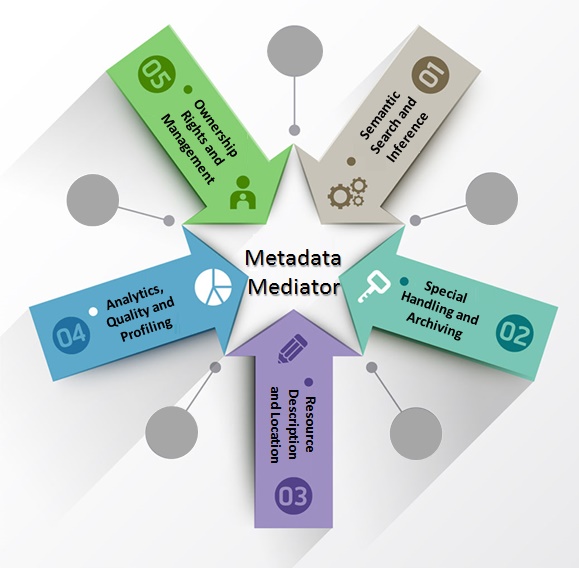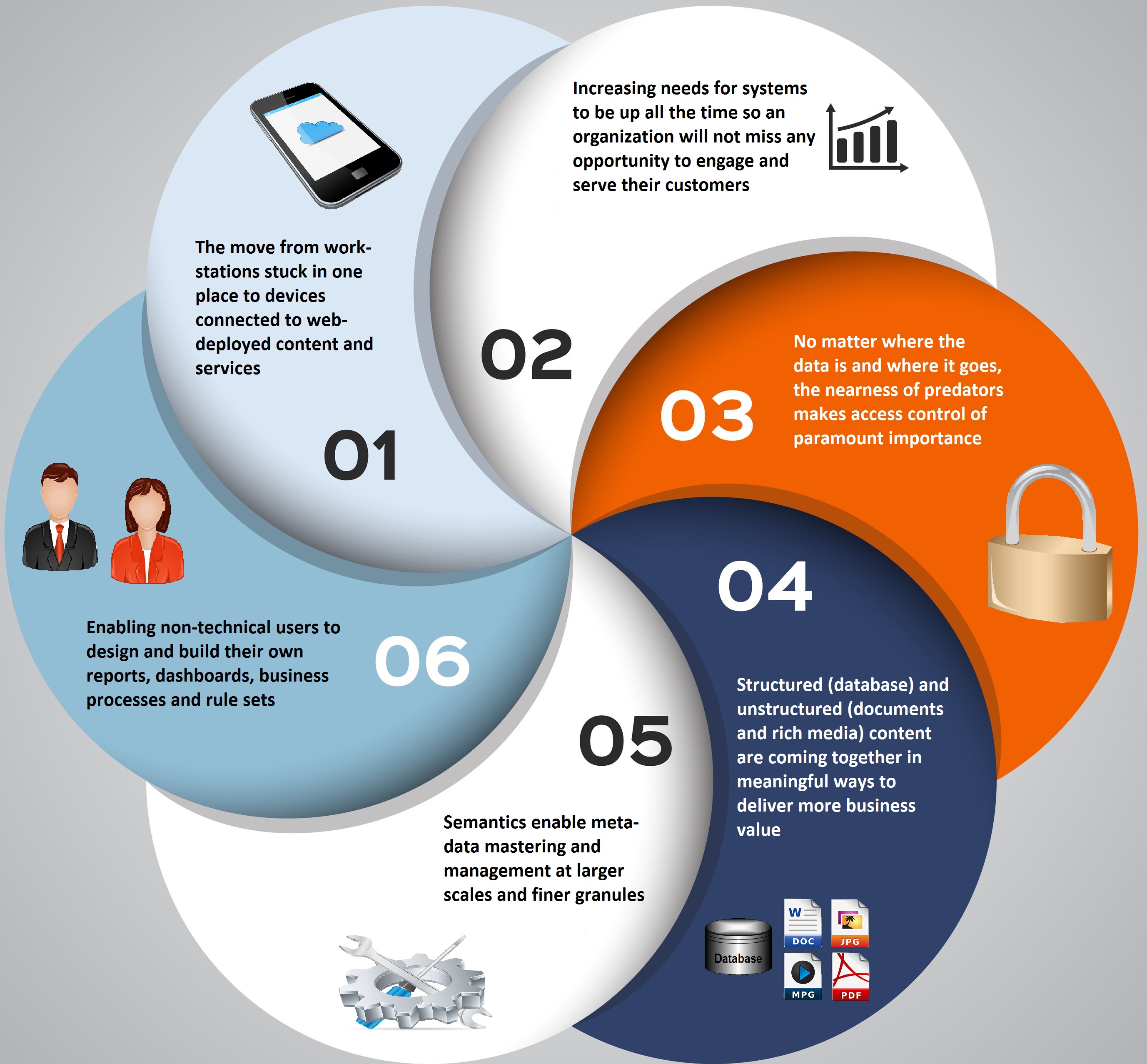27 Feb Six Reasons Businesses are Implementing Semantics
The wave is coming.
I spent some quality time last summer in a large consumer products manufacturer in Cincinnati helping architect semantic capabilities to automate tasks in chemical compliance for selling a large number of products in dozens of countries, each with hundreds of rules that apply to thousands of chemicals constituents. You can imagine the combinatorial explosion. Today I’m working for a financial services company specifying a target architecture with semantic metadata as a key component. The same things are happening in retail, government and every other sector of which I’m aware.
The technology drivers, such as mobile, social and Internet of Things (IoT) for enterprise solution implementation have significant overlap with business (industry and competitive) drivers, but technology drivers typically apply across many more diverse industries and domains. For tech companies, of course, the business and technology drivers are often one and the same. Today, I want to talk about some developments that are making feasible things that were either too expensive to build or too complex to scale just a few years ago.
| Understanding Context Cross-Reference |
|---|
| Click on these Links to other posts and glossary/bibliography references |
|
|
|
| Prior Post | Next Post |
| Inference in Knowledge Apps | Knowledge Value-Chain Instrumentation |
| Definitions | References |
| semantic meaningful | Davies 2009 Allemang 2011 |
| SaaS ACID BASE | Minsky 1968 McCreary 2014 |
| combinatorial explosion | Hirst 1987 Gómez-Pérez 2002 |
1. Mobility and Hosted Solutions
Java, and other web-based development platforms such as PHP, .Net have been significant technology drivers since the early 2000s. They enable applications to be deployed on servers in the on-premise data center or elsewhere, and used by any number of users through a browser without installing a new program on their computer. This trend has spawned new technology drivers that move more capabilities to Application Service Providers, Software as a Service (SaaS) and other remotely hosted strategies, including mobile apps that rely on hosted data. Significant business benefits and technology drivers hosting by a third party include:
- reduced costs based on a utility-like pay-per-use model;
- deliver greater scalability, flexibility; and
- greater efficiencies in terms of manageability and business process adaptation.
Additionally, hosted solutions are a good choice for companies that have limited IT manpower, expertise and resources to implement and maintain a full featured network. Sure, you give up a little control, but you save long term, and control may be overrated. Whether in the cloud or on premise, implementing semantics increases the ability to make meaningful connections between information and deliver more useful results to employees and consumers.
2. Uptime
Because the cost of downtime can be so significant, many organizations are seeking technologies that can deliver “one more 9”: instead of three nines or 99.9% uptime they want 99.99% uptime or four nines. Legacy database technologies using ACID (Atomicity, Consistency, Isolation, Durability: a set of properties that guarantee that database transactions are processed reliably) transaction methodologies historically don’t surpass two or three nines, so the Googles, Amazons and FaceBooks of the world have developed technologies that never go down because they use distributed data storage and BASE transaction methodologies (Basically Available, Soft state, Eventual consistency). BASE is technically more complex, but this complexity protects rather than befuddles users. The e-Commerce giants have been able to achieve and maintain complete reliability and complete stability (100% uptime) using BASE methods and distributed data stores. Uptime is good for other enterprises as well.
3. Secure Access
 No matter what solution options are needed, content must be protected. Information security has advanced to a point where people can safely provide credit card numbers in a web-site with confidence that they will get what they ordered and their sensitive identity and financial information is protected. This is also true about enterprise applications hosted by Application Service Providers such as Salesforce, Workday and AtTask. The hosted data is on someone else’s servers and databases, and travels frequently over the open internet, but due to encryption technology and virtual private networking, the information remains as secure and safe as it is within an enterprise’s own data center.
No matter what solution options are needed, content must be protected. Information security has advanced to a point where people can safely provide credit card numbers in a web-site with confidence that they will get what they ordered and their sensitive identity and financial information is protected. This is also true about enterprise applications hosted by Application Service Providers such as Salesforce, Workday and AtTask. The hosted data is on someone else’s servers and databases, and travels frequently over the open internet, but due to encryption technology and virtual private networking, the information remains as secure and safe as it is within an enterprise’s own data center.
Special security capabilities may be part of the implementation for any solution strategy. These capabilities may include single sign-on (SSO), Data Encryption at rest (especially if “in-memory” database technology is selected) and/or other protective measures for the new capabilities. Security measures can be implemented at any level of granularity, but the finer the parsing, the more difficult the roles and privileges model is to maintain. Again, a semantic isolation or redirection layer can simplify these management tasks, but must be designed to be foundational. Tacking on semantics after the fact can create more headaches than bargained for.
4. Converging Structured and Unstructured Data
Information in rows and columns is the bread and butter of automated capabilities, but more enterprises are learning that they can better empower knowledge workers by combining structured and unstructured information. Examples of how companies have successfully used these capabilities include responding to data requests with more than the data in the expected rows and columns:
- Definitions of the data columns
- Formulas used to derive the results
- Lineage of the data from source to destination
- Applicable narrative explanations, comments or predictions from internal or external experts
- Applicable images, sound clips or videos
- Applicable help files, process maps or training content
 The processes for obtaining and associating rich content with structured database values is new to companies that implement these capabilities. Industry experience has shown that time savings from reducing manual work, complex information hunts and rework give subject matter experts additional time to enrich the value of reports and analyses with content that improves overall outcomes and competitiveness.
The processes for obtaining and associating rich content with structured database values is new to companies that implement these capabilities. Industry experience has shown that time savings from reducing manual work, complex information hunts and rework give subject matter experts additional time to enrich the value of reports and analyses with content that improves overall outcomes and competitiveness.
Graph databases like Mongo and Neo4j, MapReduce models for Hadoop, Cloudera and Hortonworks and columnar sources like Cassandra and document-oriented stores like MarkLogic all provide remarkable mechanisms for supporting converged data. All of these are made more powerful by incorporating semantic metadata in that semantics provides the potential, in trained hands, to move the request response process from data and information to actionable knowledge.
5. Semantics Simplify Metadata Management
Canonical modeling and formalized glossaries can define consistent meanings and formulas for the data elements that constitute business knowledge and key performance indicators (KPIs). Metadata, expands a canonical model to define key data elements, and use those elements to assist in search and interpret requests for information. As metadata can incrementally, it can be used to adjust request responses as data changes without having to rebuild the entire system.
Some persistent challenges with metadata are:
- Most categorization models and lookups are still too complex and don’t reflect hierarchical relations nor inheritance
- Metadata needs to describe every business category, requiring many SMEs and making each reference less accessible
- Some formalisms require every item of metadata to have all the attributes for successful look up
- Items tagged in that record pushing metadata attributes into the thousands (from the already unwieldy 100s)
 These are vexing problems, yet for metadata to be truly helpful, it must be as complete and accurate as possible. Precisely defined categories and relationships let you quickly find data without having to know in which database or table to look. With solid metadata, when you find information you seek, you can deliver it with its metadata so that it can be adapted to the various business purposes, tasks and decisions for which it is needed.
These are vexing problems, yet for metadata to be truly helpful, it must be as complete and accurate as possible. Precisely defined categories and relationships let you quickly find data without having to know in which database or table to look. With solid metadata, when you find information you seek, you can deliver it with its metadata so that it can be adapted to the various business purposes, tasks and decisions for which it is needed.
To help manage the metadata many enterprises are turning to ontologies. These describe the meanings or semantics of data in the databases as well as files that contain rich content such as Word and .pdf documents, spreadsheets, videos, images and sound files. The ontologies define semantic and business hierarchies and support inheritance, so you don’t need to describe every attribute for every element.
6. Empowering Knowledge Workers
Business SMEs are getting more control over what they get in reports and dashboards. The self-service business intelligence (SSBI) approach lets end users create personalized reports and analytical queries while freeing up IT people to perform other tasks – potentially benefiting both groups. Because self-service BI software is used by people who may not be tech-savvy, however, it is imperative that the user interface must be intuitive and easy to use. Furthermore, SMEs need views of data definitions, formulas and lineage to be confident about the reports and dashboards they construct.
 Many business intelligence tools, including Tableau, QlikView, SiSense, MicroStrategy, Pentaho, SAS and Business Objects provide user-customizable filtering and sorting for advanced analytics and individual control of what appears on dashboards and how it is displayed. These tools vary widely in usability, and several provide metadata modeling that can simplify customizations so non-technical users can make new views without getting in trouble. To really make these tools work well for a broad spectrum of users and skills, however, semantic metadata integration is an important step forward.
Many business intelligence tools, including Tableau, QlikView, SiSense, MicroStrategy, Pentaho, SAS and Business Objects provide user-customizable filtering and sorting for advanced analytics and individual control of what appears on dashboards and how it is displayed. These tools vary widely in usability, and several provide metadata modeling that can simplify customizations so non-technical users can make new views without getting in trouble. To really make these tools work well for a broad spectrum of users and skills, however, semantic metadata integration is an important step forward.
User customizable process flows are also within reach. BPM automates people tasks, combining them with needed content through system integrations. As such, BPM enables:
- non-technical business people to define steps and flows to accomplish larger goals; and
- technical people to automate information-related steps and integrate with applicable systems.
Things like sending simple notification emails and filling out a form to complete a task don’t require technical knowledge. By default, all processes should have the ability to attach documents, links and have a discussion. With these capabilities, non technical people can already build a broad range of useful processes that don’t require technical integrations.
In upcoming posts I will continue exploring business applications for knowledge systems, what they require, and how to ensure they will bring the value needed to justify the cost and effort.
| Click below to look in each Understanding Context section |
|---|
| Intro | Context | 1 | Brains | 2 | Neurons | 3 | Neural Networks |
| 4 | Perception and Cognition | 5 | Fuzzy Logic | 6 | Language and Dialog | 7 | Cybernetic Models |
| 8 | Apps and Processes | 9 | The End of Code | Glossary | Bibliography |











[…] This bottom-up process of placing the processes and concepts in context is the foundation of the semantic enterprise. The big picture of how everything is interconnected may be difficult to understand and even a bit […]
[…] This bottom-up process of placing the processes and concepts in context is the foundation of the semantic enterprise. The big picture of how everything is interconnected may be difficult to understand and even a bit […]